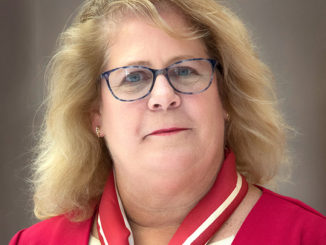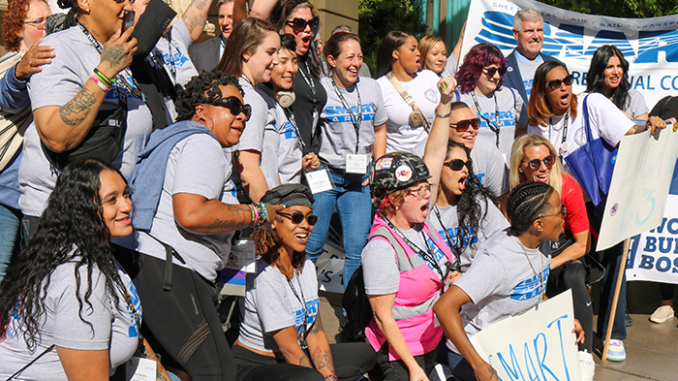
Tradeswomen Build Nations is the largest gathering of tradeswomen in the world. Hosted by North America’s Building Trades Unions (NABTU), the annual event brings more than 3,000 tradespeople, contractors, and leadership together, this year representing 48 states and ten provinces.
By / Jessica Kirby
The three-day conference featured two formal plenary sessions, a banner parade on the Las Vegas strip, and over a dozen workshops on a range of topics addressing unique and critical issues of tradeswomen in the workforce.
“The impact of TWBN and its exponential growth are phenomenal,” said NABTU President Sean McGarvey. “There is nowhere on the planet where more building trades members gather each year than at this conference, and this year, almost every general president in the building trades attended.”
Attendees included four tradeswomen and three office staff from Local 280, representing SMACNA-BC members Ridge Sheet Metal, Viaduct Sheet Metal, and Boston Sheet Metal.
Sheila Sadler has worked at Viaduct Sheet Metal for 18 years and has been in the trade for 19. She’d been a stay at home mom straight out of high school, which took her out of the paid workforce for a decade. When her marriage ended, she had a minimum wage job and still had to depend on her children’s father for financial help.
“I didn’t want to be that any more,” Sadler says. “So, I looked to the trades.”
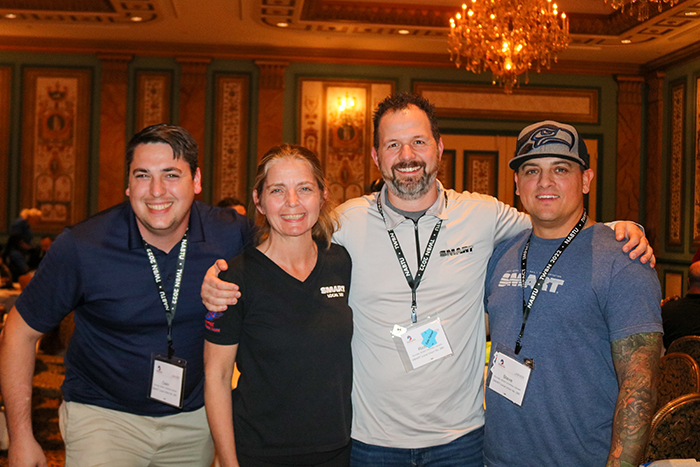
The trades discovery program at BCIT led her straight to sheet metal, and she never looked back. “I loved the metal work class and wanted to have a good stable job to raise my kids,” she says.
Similarly, Nikki Pasqualini of Ridge Sheet Metal has been in the sheet metal industry for five years and entered from high school, with her eye on a career and earning a good living. “Sheet metal was something I knew nothing about at the time, but when the opportunity arose, I took it and became the first ever female to work as an apprentice at Ridge,” she says. “The future potential and benefits were a driving factor in this decision.”
Nineteen years later, Sadler still loves her job, so much so that when she heard about the Tradeswomen Build Nations event, she was immediately interested in attending. The idea of meeting other women in trades and getting eyes on proof she’s not alone was a big draw. She wanted to find out about the challenges women face collectively and maybe even make a difference.
“I wanted to find out what I could do to make it better for everyone coming into trades and learn ways to keep us in the trade,” Sadler says. “I am also interested in ways to bring women into the trades and help them find jobs that could change their lives for the better—pick them up.”
Pasqualini decided to attend because she wants to be more involved in the union and the industry, and she also wants to learn how to be more of an advocate for her fellow tradeswomen.
“I wasn’t too sure what to expect, although I was told it would be an empowering experience,” she says. “The convention exceeded my expectations. The amount of powerful and strong women in one room just blew me away.”
For Sadler, the meeting in the Great Hall was the event highlight. “It was the most powerful experience I have ever felt,” she says. “The pride that was in that room was overwhelming. I felt connected to 3,300 people all at one time. I have goosebumps thinking about it.”
That feeling resonated throughout the weekend, and among women and men in all trades who attended the event. “People on the street could feel the energy when we went on a small walk about,” Sadler says. “It was amazing to see and feel.”
One of Pasqualini’s favourite parts of the conference was the banner parade. “Having over 3,000 women march, union strong and proud down the strip, was such an amazing experience,” she says. “The crowd watching cheered for us and chanted with us. As someone who has not had the opportunity to work with too many women, it was breathtaking to see the amount of support there is out there.”
Among many lessons gleaned at the event, Sadler learned that daycare is a huge issue in the industry because they days start early and daycare hours don’t often align. This poses a difficult barrier for single parents, most of whom are women.
“We need a better support system for retaining these workers,” Sadler says. “We are here to help fill the jobs that the industry so desperately requires and to take care of our families, the same as any other construction worker.”
Another key takeaway was from the workshop “Bullying and harassment – Don’t be that guy”. “Bullying and harassment, unfortunately, happens in many work places, especially for women and apprentices in trades,” Pasqualini says, noting instances where co-workers are bystanders to bullying and do nothing to help or deflect because they themselves are afraid of retaliation.
“ʻSilence is compliance’ was a phrase that stood out to me,” Pasqualini says. “We as tradespeople need to work on how we treat each other because times have changed, and this is not a man’s job or a woman’s job. This is OUR job.”
Sadler feels as though barriers women face when entering trades may sometime exist simply because others don’t understand why women want to work in trades.
“Not everyone is made to work in a retail or office space,” she says. “Some are meant to work with their hands and minds. And just because I was born into a female body doesn’t mean I am not capable of doing a trade. I might have to use my body differently than a larger man would, but I am still very capable of doing the work. I love the challenge everyday of figuring out the work I have ahead of me.”
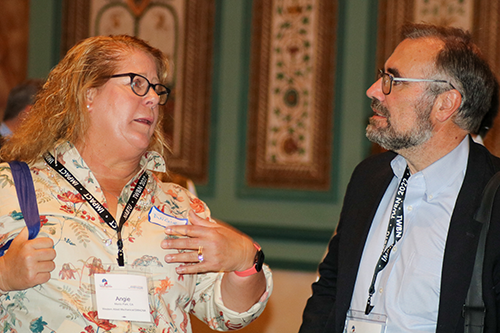
Angie Simon, past SMACNA National president, attended and was most impressed by how many allies (male supporters) that attended the event. “SMART General President Joe Sellers and his top people as well as many business managers and JATC trainers were there to support the SMART women,” Simon says.
SMACNA held its Women’s Summit with 50 attendees on Thursday in Las Vegas before the Friday event started to encourage SMACNA attendees to stay and also attend TWBN.
“There were about 10 SMACNA folks that stayed for the Friday and Saturday events,” Simon says. “This included SMACNA CEO Aaron Hilger. SMACNA attendees were also invited to the SMART reception on Friday.”
“The men who attended this event told me it was eye opening!” Simon added. “They heard stories and attended panel discussions that made them even more aware of what their female sisters have had to endure being the only women on a jobsite. So, for their awareness, it is excellent that they attended. For the women, it was a chance to celebrate their success, not feel so alone and bond and network with other women that have been working in the trade, as well. Plus, the educational content was solid.”
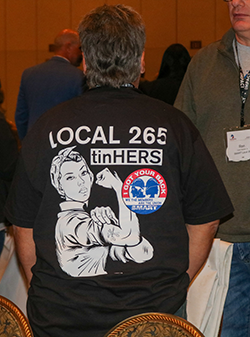
Sadler encourages anyone thinking about attending TWBN in the future: “Do it!” she says. “It was one of the most powerful things I have ever done. It would also help people to see that these women just want to work and do a good job.”
For future attendees, Pasqualini recommends taking the time to listen to people’s experiences and stories, which can be a good source of learning how to navigate future situations.
“Be open to networking and making connections,” she says. “It’s hard, but it will be worth it. Finally, don’t be afraid to speak up and tell your story.”
McGarvey says trailblazing tradeswomen are leading the future of construction, and empowering them is the best way to increase opportunities for and retention rates of women in unionized trade careers.
“Every day, inspiring tradeswomen advance and recruit more women into the family-sustaining unionized construction careers our affiliates provide,” he says. “This conference was a celebration of these sisters and a testament to the growth of tradeswomen in our ranks.”
Pasqualini agrees. “We need to work together, respect one another and not treat others as if they are below us, even if they have less training or make less than us,” she says. “We need to build up apprentices and women in the trade as they are our future.” ■



